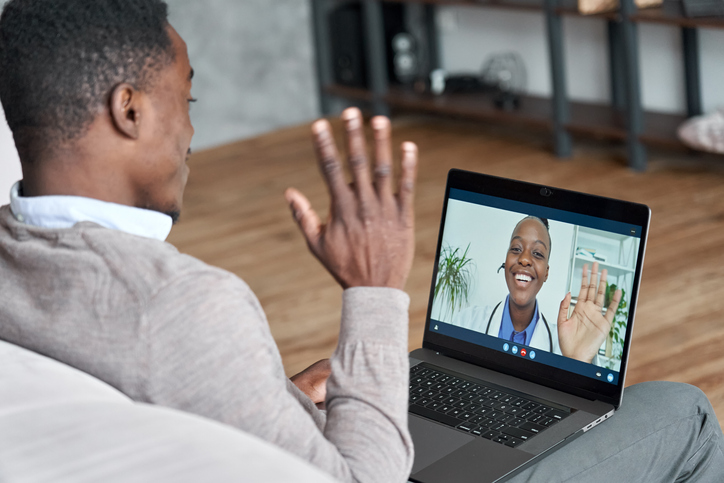
As appeared in the Fall 2021 issue of Scripts.
As Dave Street’s article “The Rise of The New Digital Outpatient Clinic (Telemedicine)” pointed out, the technology, refinement, and implementation of telemedicine into the daily clinical practice of medicine was enhanced and accelerated by the COVID-19 pandemic.1 In most all types of clinical practices – from primary care, to surgical specialties, and others – the need to continue to connect with our patients who couldn’t safely be seen in our offices at the time was realized. Both their safety and well-being, as well as that of our office staff was paramount during the throes of the pandemic before vaccines and enough PPE were available. We did what we needed to do to serve our patients and keep our practices going.
However, though our offices have better adapted to welcoming patients back in person over the past 1½ years, the usefulness of telemedicine as part of our everyday clinical practice has been realized. Whether ‘seeing’ ill patients - possibly with COVID-19 infections and needing our ‘drive by’ COVID-19 testing, or others needing ongoing chronic or acute care who ‘just can’t make it ‘ into the actual office that day due to work or other time constraints, telemedicine has solidified itself as an acceptable form of completing a clinical visit in appropriate cases.
But what about patient acceptance and the effects on the physician – patient relationship of telemedicine?
The definition of the physician-patient relationship is generally accepted as ‘a consensual relationship in which the patient knowingly seeks the physician’s assistance and in which the physician knowingly accepts the person as a patient.’2 There is no statement included in this court case [QT, Inc vs Mayo Clinic, Jacksonville] regarding the manner in which a patient may come to a physician and initiate this relationship. In this increasingly ‘consumer centric’ world of health care, relationships change to meet new expected patient standards. This includes the new ‘digital world’ that is rapidly evolving in all aspects of our lives. This digital world includes telemedicine.
Anecdotally, the providers at our three Northside Primary Care Associates offices (and likely your practices too) have received overwhelming positive feedback, praise for, and acceptance from patients who have been and continue to be seen via telemedicine opportunities. Several studies published over the past year have also confirmed and reinforced these findings.3,4 Though most of these are retrospective observational studies, they consistently report patient satisfaction rates of 95-100% regarding telemedicine visits compared to ‘in person’ visits.
While acknowledging limitations of this type visit (including an actual ‘hands on’ exam), appropriate patient problems and health complaints have been handled – including those for acute illnesses as well as routine follow ups of chronic conditions. Arrangements are easily made either before a schedule telemedicine appointment or just after to obtain needed or requested laboratory testing or patient imaging. Our patients have lauded the timely scheduling of these visits and, of course, the convenience of being at home, at work, or even in a shopping center parking lot while conducting an encounter.
We feel, and these recent surveys and studies support, that telemedicine visits initiate ‘new’ and confirm, maintain, and enhance ‘established’ physician – patient relationships. We are better able to meet the needs of our patients in a timely and safe manner and adjust to their individual clinical situation.
As is likely the case with most of you, the success of these visits, as well as continued payer reimbursement beyond the acute pandemic authorization, have convinced us to continue these types of visits and, in some cases, set aside scheduled provider time for telemedicine as part of the regular clinical day. Providing ‘evidence based’, compassionate care with shared decision making contributing to a strong physician – patient relationship are our goals within our individual practices. Adding to that the convenience of telemedicine for appropriate cases only helps to grow and solidify the relationships we have with our patients.
References:
- Dave Street, “The Rise of The new Digital Outpatient Clinic (Telemedicine),” Scripts, Spring 2021, 8-9.
- Jacque Von Speyer, Jacques, “The Physician – Patient Relationship in Telemedicine,” March 23, 2020, www.openpr.com/news/1978220/thephysicianpatientrelationshipin telemedicine.
- Orrange S., Patel A., Jean-Mack W., & Cassetta J.(2021).Patient Satisfaction and Trust in Telemedicine During the Covid-19 Pandemic: Retrospective Observational Study. JMIR Human Factors, 2021 Apr-Jun;8(2): e28589
- Nguyen M., Waller M., Pandya A., & Portnoy J. (2020). A Review of Patient and Provider Satisfaction with Telemedicine. Curr Allergy Asthma Rep. 2020. Sep 22;20(11):72. Doi:10.1007/ s11882-020-00969-7.

